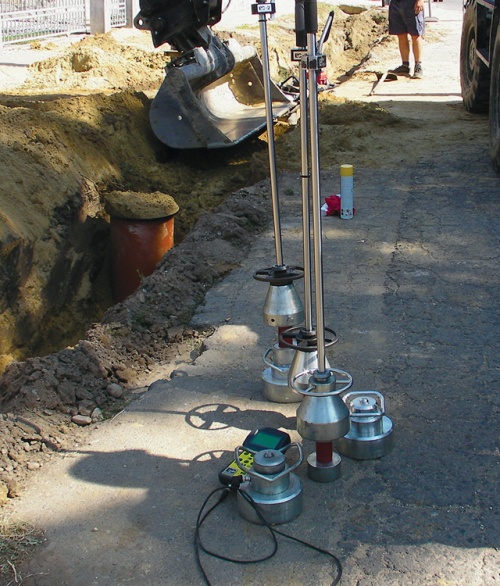Contractor’s self-control on Earthworks
The AASHTO T-191 Sand-Cone test needs too much time and hard work. The CWA15846 Measuring method for Dynamic Compactness & Bearing Capacity with Small-plate Light Falling Weight Deflectometer standard test gives the only solution. The self-control concept of the ISO 9001 is important, and a contractor has not had any opportunity until now. Only the laboratory was able to qualify their earthwork – ex post and not during the construction. This has now become possible with a new simplified, inexpensive device, the BC2. The quality of earthwork is feasible avoiding the settlement. Immediate, in-situ monitoring of the earthwork is possible using the BC-2 solely.

BC-2 simplified SP-LFWD is a new test method to measure the compactness-rate of earthwork and granular material layers. The measurement method has been developed by ANDREAS Ltd. The procedure is patented throughout the world – from US to Europe. The new dynamic compactness measurement is the coming method because traffic load is dynamic as well.
Control Your earthwork with BC-2
The knowledge of compactness-rate and bearing capacity is crucial for any building project. The whole further construction, including the built structure, is affected by these parameters, therefore its control is of high importance. Control is set in requirements of earthworks for road, bridge, waterway, and railway constructions. There is only one solution – the B&C – that can measure these two parameters with one device (Nuclear Density Test + Load Plate Test = B&C), therefore these are protected patents.
Contractors are working blindly today, though they – applying the ISO 9001 Quality Management System – would like to know the quality of the earthwork done and whether additional compaction is needed or not. BC-2 is the suitable easy-to-use device for immediate, on-site decision-making. Due to its simplicity, measurement can be carried out by anybody.
The B&C simultaneously measure the Trd% and the Ed of the layer or soil. Compared to the former solutions, this method is less affected by the ρdmax value generated by the deviation of Proctor density. The test result must be given from two parallel tests, the differences of results should be smaller. Therefore the dynamic compactness rate is a more accurate, safer and simpler measurement method to describe compactibility.
Compactness requirements are included in the standards all over the world. These are usable also, because the compactness-rate from density-ratio is equal with the B&C theory calculated from deformation. Until now compactness-rate was determined from the moist density, sampling cylinder, sand cone test or isotopic measurement (NDT). Theoretical conformity to density measurement-based methods has been deduced and published. The new dynamic compactness measurement method gives the same result as the previous tests – but it is ten times more accurate than the isotopic one. Due to this fact, all requirements and thresholds must be taken into consideration invariably.
Bearing capacity requirements are regulated by standards all over the world. All of these requirements can be controlled by the B&C device. The equality of E2v and Ed has been tested on a large number of samples. The great advantage of B&C is that its press under the plate is identical to the end load of the static E2v test of EN-DIN-ASTM. Therefore Ed should not be converted, it provides approx. the same value as the static method. For this reason, threshold values given for E2v can also be used for dynamic test. The formula is similar.
The disadvantages of static plate loading measurement are well-known: a counterweight is needed for loading, it is slow, as one test can be performed in half an hour. There is no parallel testing. The equipment used by the 30 years old LFW load system is increasingly recommended. LFWD-BP big-plate bearing capacity measurement supports different standards (TP BFStB Part8.3, ASTM E2835-11), but this method measures no compactness. Due to the 300 mm plate size, the press under the plate is only 0,1 MPa. Therefore the measured Evd value is not identical to E2v. The reliability of defined regression relationships is bad. For this reason, using B&C for bearing capacity measurements is more favourable.
BC-2 - 3in1 solution
B&C equipment can be also used with big plates, so both LFWD-BP and LFWD-SP tests can be carried out. However, Trd% dynamic compactness-rate, Ed dynamic modulus, and EdEnd modulus can only be measured by the BC-2 small-plate device. According to the CWA15846 Standard p = 0,35 MPa press occurs under the plate, well characterizing currently increased axle weights in road and in railway. However BC-2 can be used with big plates too. If the BC-2 device is used along with other software and with a big plate the TP BFStB Part8.3, or ASTM E2835-11 tests can be carried out.
BC-2 – simplified measuring device
BC-2 is a simplified device, contrary to BC-1, the under-plate settlement is measured not by an accelerometer and a quartz-clock mounted on the plate, but from the fall weight rebound. The equipment has been developed for self-checking; it is not certified and is not suitable to carry out accredited qualifying measurements.
Simplified data processing
Two types of simplified reading & calculating method and accurate calculation method may be done. Simplified processing is reasonable to use when carrying out self-checking for ISO 9001 or in case of information measurement.
Compactness-rate
For compactness check drop as many times as necessary until rebound height increases no further and remains the same (min 10, max 18). Measured compactness-rate is proportional to the height difference between the first and the last rebound.
A compactness-rate ruler is in the accessories, to read the TrE%. The smaller the difference, the higher the compactness.
Calculate in mind: the difference is ΣΔsum (mm). TrE% = 100 – (4 ⋅ ΣΔsum)
Ed – Dynamic modulus
Using simplified reading, it is enough to check the position of the reference sign ring compared to the red, yellow or green line-marking.
Line reading: drop 5, after the 6th read the position of the sign ring on the bar:
Red line, s < 1.10 mm: E2 > 25 MPa Foundation layer of embankment appropriate
Yellow line, s < 0.70 mm: E2 > 40 MPa Earthwork top-surface appropriate
Green mark, s < 0.40 mm: E2 > 65 MPa Protection-layer appropriate
The harder the measured layer, the higher the rebound.
Detailed data processing
The results of the measurement, relative compactness-rate, dynamic bearing capacity, settlement on 25 cm layer, bedding coefficient of subgrade and the end-modulus can be calculate with a diagram.
Calculate the compactness-rate
One can calculate the compactness-rate with 1% accuracy without computer. Precise calculation is: determine deformation index Dm → TrE% → Trd%
Dm = 2482/2000 = 1.24 mm → TrE% = 100 – (1.25 ⋅ 3.8 ⋅ Dm) = 94% → Trd% = TrE% ⋅ Trw = 94 ⋅ 0.97 = 91%
Calculate settlement (layer compression in the future) for 25 cm
Multiply 10 ⋅ Dm for determine settlement 25 cm layer thickness! It refers to filling or backfilling utilities of 50 cm if doubled, 1 m if quadrupled. Expected consolidation for 1 m thick layer = 4 ⋅ 10 ⋅ 1.24 mm = 49.6 mm = 5 cm in this sample, if the layer reaches a compactness rate of 100% in a few years.
Calculate dynamic modulus (Ed)
Value of Ed dynamic modulus characterizing bearing capacity can be calculated easily, with a simple division: Ed = Cµ / S1a where settlement amplitude S1a = (drop No. 4 + 5 + 6) / 3 (mm)
Cµ = comes from the Boussinesq formula:
Semi-cohesive material (silt) µ = 0.4 Cµ = 37.6
Cohesive material (clay) µ = 0.5 Cµ = 33.6
Calculating dynamic end-modulus (EdEnd) shows what can be reach with maximum compaction. It is calculated from the last 3 drops. EdEnd = Cµ / S5a where S5a = (drop No.16 + 17 + 18) / 3 (mm)
Moister Correction Coefficient
The BC-measured TrE% must be multiplied by the Trw moister correction coefficient to get the Trd% compactness-rate. Trw < = 1, the normalised Proctor-curve, got from the Proctor test Trw = ρdi / ρdmax. If the water content is + / –3% at the optimum, then the Trw value is approximately 0.97-1.
Corrections and conversions
Dynamic modulus correction due to the law of impulse: every dynamic modulus should be corrected (German-type and ASTM also) depending on soil density. Impulse depends of mass and falling velocity, that for soil depends on soil density supposed a given effect depth. Correction must be done for Ed only, it has smaller effect on TrE%. Correction must only be done if Proctor-density significantly deviates from the usual, in case off fly-ash, slag or other high-density materials Ed KORR = Ed ⋅ K where K = 1.766 / [ρdmax ⋅ 1 / (1 + wopt)]
Correction and control of the BC compaction work (or > 29 cm thickness)
After the first compactness measurement (18 drops) we do one more test without moving the plate. If this second measurement is TrE2% ≤ 98%, we correct our first measuring results; if it is bigger or equal, we can accept the further measurements without correction. CWC = TrE2% / 100 and TrwK = CWC ⋅ Trw
Correction for simplified Proctor compaction-rate (to use in German area):
The dynamic compaction rate works with modified Proctor (in the Trw).
The simplified (standard) compactness-rate one can calculate β = (ρdmax simplified) / (ρdmax modified) and Trd simplified% = (1 / β) ⋅ Trd%
E2v from BC-2 dynamic test: the static modulus E2v ≅ Ed or E2v = 0.94 ⋅ Ed with regression R2 = 0.93, so it is approximatively the same value as the SP-LFWD’s Ed value.
Dynamic Bedding Coefficient from BC-2 test: used in industrial flooring
cd = 0.0761 / S0a (N / mm3) where S0a = (drop No. 1 + 2 + 3) / 3 (mm) regression R2 = 0.92
Evib from BC-2 dynamic test:
Evib = 0,5Ed + 57 (R2 = 0,93) Evib is well-known from the CCC-method
CBR% from BC-2 dynamic test:
One can calculate it from the second three BC settlement values:
CBR% = 2.4 ⋅ S1a–0,67 (%) where S1a = (drop No. 4 + 5 + 6) / 3 (mm)
Evd from BC2 dynamic test:
Evd = 0.42Ed (R2 = 0.90), or Evd = 0.69Edend (R2 = 0,91)
Conversions are approximatively informative values, but they show, that the regression degree is rather good. This means that BC-2 is a very useful device in civil engineering practice.
Price: only 3499 € ex. VAT.•





























